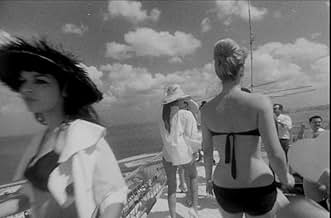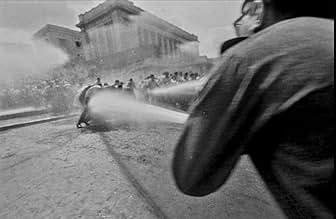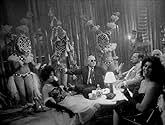IMDb-BEWERTUNG
8,2/10
11.542
IHRE BEWERTUNG
Vier Episoden über das Leben in Kuba vor dem Hintergrund der vorrevolutionären Ära.Vier Episoden über das Leben in Kuba vor dem Hintergrund der vorrevolutionären Ära.Vier Episoden über das Leben in Kuba vor dem Hintergrund der vorrevolutionären Ära.
- Regie
- Drehbuch
- Hauptbesetzung
- Auszeichnungen
- 2 Gewinne & 1 Nominierung insgesamt
Mario González Broche
- Pablo
- (as Mario González)
Empfohlene Bewertungen
That I've ever seen, and I watch a lot of movies. The story is propaganda, to be sure, and some of the acting is horrible, but WOW! I couldn't take my eyes off of it. Shot after stunning shot....I don't know how they did it, but I didn't mind all the rhetoric because I kept thinking, "Look, that's so beautiful" and "Wow, how did they do that?" I do recommend it also as a historical document of a time most people don't remember....I was born the year it was made and remember "the Communist Threat" but I think a lot of people younger than myself may not remember.
Not to mention that yes, some of the music was also amazing. A must see for any serious film buff.
Not to mention that yes, some of the music was also amazing. A must see for any serious film buff.
I am Cuba/Soy Cuba features the stories of several Cuban citizen-types: a young prostitute, a farmer, a young revolutionary and so on, up to the start of the island's Castro Revolution.
If this sounds dull, then rest assured that the plot is minimal and, despite it's avowedly political purpose, hardly gets in the way of the film's main attractions today. What distinguishes the production is the cinematography. It is not an exaggeration to say that the images and technique in the film are breathtaking, and it is a tour-de-force of bravura camera work. Apparently Martin Scorcese has screened this film privately to work out how such-and-such a shot was achieved, and perhaps it's influence can be found in the famous through-the-kitchens tracking shot in 'Goodfellas'.
This is a film where the camera is constantly in motion, with sweeping balletic long takes, crane and hand held shots, tracking shots, including some over and down the side of buildings, through cane fields, into swimming pools, around packed night clubs, even hovering and moving along high over a street in the middle of a packed funeral procession - all without the usual cutting. I estimate the average length of a take in this film at about 2 - 3 minutes, a figure rare and astonishing these days, even with the benefit of steadicams - but jaw dropping given the still-unwieldy equipment they were surely using in 1964. In particular one or two large scale sequences must have taken days, if not weeks, to prepare, and presumably needed government marshaling to choreograph. (Ironically, whether or not the film makers intended it, the liberated camera work on display here reflects the notion of revolutionary freedom far more than the actual story vignettes.)
The film itself is shot in high contrast gleaming black and white, favouring wide angle lenses, and with a constant deep focus that reminded me of Greg Toland's work for Welles or some of James Wong Howes' work. Kalatozov's use of a handful of character 'types' throughout recalls Eisenstein's (and in fact there is a faint reference to his the Odessa Steps sequence in 'Battleship Potemkin' at one point when the revolutionary rioters march down some steps), but the effect here is far more sensual and lyrical. (Among the professional actors, Sergio Corrieri also appears in the better-known Memories of Underdevelopment). The film's 'artiness' is undeniably a distraction from the message of struggle, and to the original viewers the beautiful images must have been a long way from reality in the New Cuba.
Today we don't have this problem and the viewer is left with a visual feast to enjoy over and over again..
If this sounds dull, then rest assured that the plot is minimal and, despite it's avowedly political purpose, hardly gets in the way of the film's main attractions today. What distinguishes the production is the cinematography. It is not an exaggeration to say that the images and technique in the film are breathtaking, and it is a tour-de-force of bravura camera work. Apparently Martin Scorcese has screened this film privately to work out how such-and-such a shot was achieved, and perhaps it's influence can be found in the famous through-the-kitchens tracking shot in 'Goodfellas'.
This is a film where the camera is constantly in motion, with sweeping balletic long takes, crane and hand held shots, tracking shots, including some over and down the side of buildings, through cane fields, into swimming pools, around packed night clubs, even hovering and moving along high over a street in the middle of a packed funeral procession - all without the usual cutting. I estimate the average length of a take in this film at about 2 - 3 minutes, a figure rare and astonishing these days, even with the benefit of steadicams - but jaw dropping given the still-unwieldy equipment they were surely using in 1964. In particular one or two large scale sequences must have taken days, if not weeks, to prepare, and presumably needed government marshaling to choreograph. (Ironically, whether or not the film makers intended it, the liberated camera work on display here reflects the notion of revolutionary freedom far more than the actual story vignettes.)
The film itself is shot in high contrast gleaming black and white, favouring wide angle lenses, and with a constant deep focus that reminded me of Greg Toland's work for Welles or some of James Wong Howes' work. Kalatozov's use of a handful of character 'types' throughout recalls Eisenstein's (and in fact there is a faint reference to his the Odessa Steps sequence in 'Battleship Potemkin' at one point when the revolutionary rioters march down some steps), but the effect here is far more sensual and lyrical. (Among the professional actors, Sergio Corrieri also appears in the better-known Memories of Underdevelopment). The film's 'artiness' is undeniably a distraction from the message of struggle, and to the original viewers the beautiful images must have been a long way from reality in the New Cuba.
Today we don't have this problem and the viewer is left with a visual feast to enjoy over and over again..
I had no idea what this film was about or when it was shot when I watched it. About an hour & a half into it I realized that I was mesmerized. I was weary from not blinking while I watched silently and then realized that I'd not moved from the moment of that first long shot from the party atop the hotel, which wound through the crowd into a pool below.
Somewhere during the cabal in the night-club where we watched a young woman dancing disconcertingly and harnessed, I became riveted. Then as we watched her being followed home through a ghetto by a man from the club I felt like a voyeur, which worked through the end of that story and melded seamlessly into the next.
It is a story starting at night as a young woman is approached and intimidated by a bunch of US Sailors and another clean cut Cuban student comes to her aid. Still I was feeling like I was just inside a window somewhere watching these people who might turn and look up to spot me at any moment. So I remained still and quiet through almost the entire film, and continued following the student and watching his attempts at assassination and his friends' deaths because they "doth protest too much".
Then I'm standing just behind a farmer melancholy in his doorway remembering... thinking as his grown children sleep just nearby. They all wake to work the land with their father. The images are starkly bright whites sliced by black shards of shadows and shapes that make up the surrounding overgrown land, buildings, people and that lone horse. I realize my stillness when my hypnosis is broken by the landowner riding up to tell the crushed old man that the land has been sold. He feigns being OK by sending his kids off to town to enjoy some sodas and music, for all their hard work. Then he burns their home to the ground.
I think it is here that I take my first breath in 90 minutes -I exhale. Then the next think you know, I'm hiding and watching again, this time in the mountains and a guerrilla, who at first seems lost, lands on the doorstep of a small rural family with at least one child running around bare bottom. Everyone here looks weary and dirty, the soldier also, who is invited in to eat. As he eats the wife crushes corn in the background like the rhythm of a snare to the smoky voice of a jazz singer as the soldier speaks of revolution. The father strangely can't take this kind of aggressive thinking and has the guerrilla to leave. Just as I try to inhale, a bomb hits just next to the little raggedy house in the hills and the family makes a hasty retreat, but father and son get separated from mother and children. It's dangerous and sad, serious and almost silent. The little naked boy who retreated with his agonizing father gets killed. Father is reunited with his family under a cave-side waterfall. Pain, loss, grief, anger - he goes to join the revolutionaries in a final act of leaving his little family behind.
Now I've watched the entire film and I'm still not sure how I feel about it all, but I'm breathing again, and I continue to live with the images.
That is a good film experience.
Somewhere during the cabal in the night-club where we watched a young woman dancing disconcertingly and harnessed, I became riveted. Then as we watched her being followed home through a ghetto by a man from the club I felt like a voyeur, which worked through the end of that story and melded seamlessly into the next.
It is a story starting at night as a young woman is approached and intimidated by a bunch of US Sailors and another clean cut Cuban student comes to her aid. Still I was feeling like I was just inside a window somewhere watching these people who might turn and look up to spot me at any moment. So I remained still and quiet through almost the entire film, and continued following the student and watching his attempts at assassination and his friends' deaths because they "doth protest too much".
Then I'm standing just behind a farmer melancholy in his doorway remembering... thinking as his grown children sleep just nearby. They all wake to work the land with their father. The images are starkly bright whites sliced by black shards of shadows and shapes that make up the surrounding overgrown land, buildings, people and that lone horse. I realize my stillness when my hypnosis is broken by the landowner riding up to tell the crushed old man that the land has been sold. He feigns being OK by sending his kids off to town to enjoy some sodas and music, for all their hard work. Then he burns their home to the ground.
I think it is here that I take my first breath in 90 minutes -I exhale. Then the next think you know, I'm hiding and watching again, this time in the mountains and a guerrilla, who at first seems lost, lands on the doorstep of a small rural family with at least one child running around bare bottom. Everyone here looks weary and dirty, the soldier also, who is invited in to eat. As he eats the wife crushes corn in the background like the rhythm of a snare to the smoky voice of a jazz singer as the soldier speaks of revolution. The father strangely can't take this kind of aggressive thinking and has the guerrilla to leave. Just as I try to inhale, a bomb hits just next to the little raggedy house in the hills and the family makes a hasty retreat, but father and son get separated from mother and children. It's dangerous and sad, serious and almost silent. The little naked boy who retreated with his agonizing father gets killed. Father is reunited with his family under a cave-side waterfall. Pain, loss, grief, anger - he goes to join the revolutionaries in a final act of leaving his little family behind.
Now I've watched the entire film and I'm still not sure how I feel about it all, but I'm breathing again, and I continue to live with the images.
That is a good film experience.
Just about every comment posted here eulogises Soy Cuba's camera-work, which is certainly understandable as it is remarkably filmed, but this is done to the neglect of other extremely important aspects. Whether they are bigger fans of the camera-work or of the direction, however, all the commentators on these pages seem to share the caveat that arguably the main point of the film - its plot - amounts to nothing more than "silly propaganda" or a curiosity of totalitarian film making. Such an attitude is a terrible oversight! Soy Cuba is about people's desire for freedom and a better life, and the revolutionary potential of this desire when conditions reach a point beyond which people will no longer endure. It is about self respect, and courage, will and humanity and a human, filial patriotism; it is about the distillation of Cuba as an idea and a cause for justice and empowerment. I cannot understand how deeply postmodern and jaded, or just plain superficial, someone has to be to notice all the nuances of angle and light and completely miss the deep emotional and spiriual poetry of the content (in fact, the US government certainly paid good attention, for it banned the film until 1992)! It is like discussing Korda's portrait of Che Guevara in terms of focus and aperture alone!Did they not feel goosebumps as they watched the scene of the students on the steps, and the dead dove? I am lost for words! Indeed, if it were just a vapid propaganda piece, what explains its de facto censorship in the Soviet Union? I am quite sure that many of these commentators must have visited the Caribbean on holiday at one time or another; I know from my own experiences, and they ought to have immediately realised on seeing the film, that the portrait the it paints of Cuba remains the reality of Jamaica, Dominican Republic, Haiti today, some 65 years later. Watching this film, we should above all feel indignant, rather than heaping praise onto disembodied and decontextualised technicalities such as camera-work. To dismiss it as propaganda yet ogle at its images is akin to prostituting this beautiful, very deeply moving, and inspiring film, the same way that Cuba herself was prostituted. Shame on you.
Every frame of this film deserves to be printed, framed and hung in a gallery. And the sound, wow. The sound... Crunchy super-intimate sounds- like the sound of machetes ringing in the cane field- are as evocative as the images.
1964. It's amazing how much can be done with so little...
1964. It's amazing how much can be done with so little...
Wusstest du schon
- WissenswertesThe now famous long take that begins at the top of the hotel, then winds around and down into the swimming pool, originally come out of the water and continued. The camera was hand held, passed from crew member to crew member, to make its way down the side of the hotel into the pool. The camera lens had been equipped with a high speed, spinning glass disk taken from a submarine periscope. The spinning disk was installed to fling water drops off of the lens when the camera emerged from the swimming pool at the end of the shot. Much to the disappointment of the camera crew, director Mikhail Kalatozov cut the end of the take, ending it underwater.
- PatzerWhen Enrique gets to the top of the high-rise building he gains access to the roof by stepping through a window with a broken pane of glass. When he returns, the pane in same window is unbroken.
- VerbindungenFeatured in Soy Cuba, O Mamute Siberiano (2004)
- SoundtracksLoco amor
(Spanish-speaking adaptation of the 1958 song "Crazy Love")
Music and lyrics by Paul Anka
Performed by El Duo Los Diablos (as Los Diablos Demonicos)
Added accompaniment music recorded later at the Prado 210 studio
With Chucho Valdés (piano), Guillermo Barreto (drums) and Orlando "Cachaito" Lopez (bass).
Top-Auswahl
Melde dich zum Bewerten an und greife auf die Watchlist für personalisierte Empfehlungen zu.
- How long is I Am Cuba?Powered by Alexa
Details
- Erscheinungsdatum
- Herkunftsländer
- Offizieller Standort
- Sprachen
- Auch bekannt als
- Soy Cuba
- Drehorte
- Calle M & 23 Ave, Havanna, Kuba(rooftop scene: Enrique as a sniper)
- Produktionsfirmen
- Weitere beteiligte Unternehmen bei IMDbPro anzeigen
Box Office
- Bruttoertrag in den USA und Kanada
- 168.100 $
- Weltweiter Bruttoertrag
- 274.098 $
- Laufzeit2 Stunden 21 Minuten
- Farbe
- Sound-Mix
- Seitenverhältnis
- 1.37 : 1
Zu dieser Seite beitragen
Bearbeitung vorschlagen oder fehlenden Inhalt hinzufügen
























